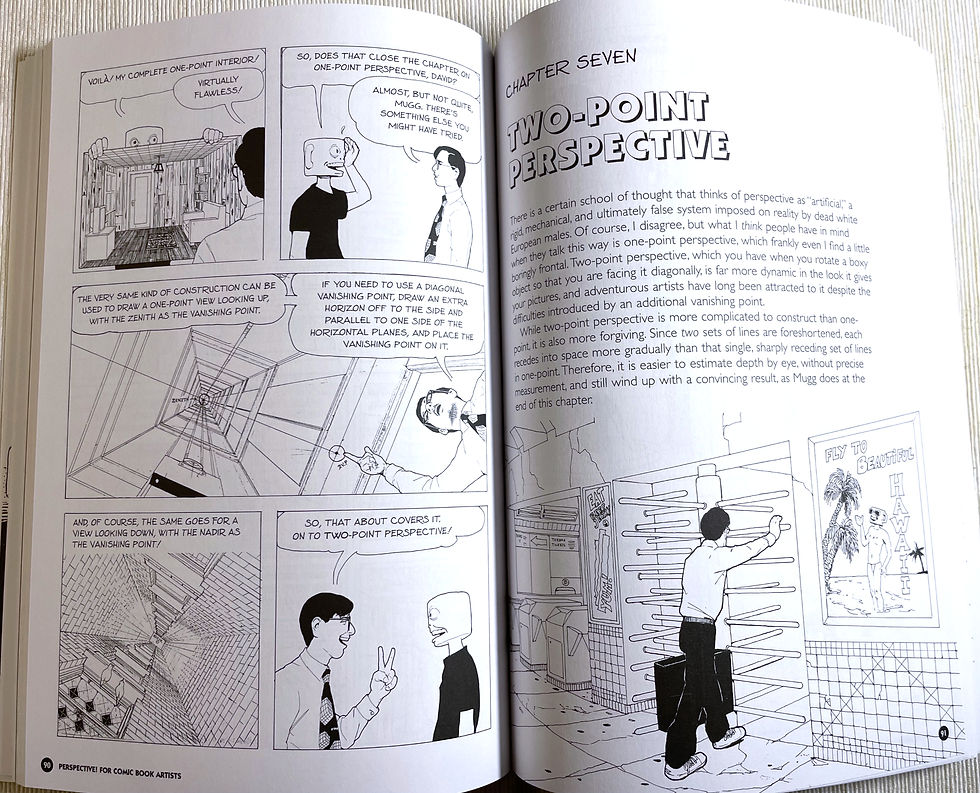How to Draw Comics: My Favorite Books for Learning Comic Art
- Sarah Nelson

- Aug 25
- 4 min read
When I started learning comic art, I realized there’s no single book that covers everything. Comics are a mix of storytelling, illustration, design, pacing, and acting. I figured the best way to grow as an artist would be to study each part in depth separately and then combine them.
Over the years, I’ve collected a small library of books that I return to. Some helped me with anatomy, others taught me how to make a panel flow, and a few gave me those “aha!” moments that changed how I think about storytelling.
Here are my favorites, grouped by topic:
For Learning the Craft of Sequential Art:
These books are all about the art of telling a story in panels, choosing the right shot, guiding the reader’s eye, and blending words and pictures.
Mastering Comics by Jessica Abel & Matt Madden


This book is my favorite on teaching the basics of comic making. It's essentially a college-level comics course in book form. It’s packed with exercises that prompt you to think more intentionally about story structure, pacing, and panel choices. If you are a beginner and want a book that teaches but also gives course-like exercises to help you learn, this is the book.
⭐ Buy it here: Mastering Comics: Drawing Words & Writing Pictures Continued
Comics and Sequential Art by Will Eisner



I love this book. Eisner is a master cartoonist (The Spirit, A Contract with God). He not only pioneered the art form, but the The Eisner comic industry awards are named after him.
This book breaks down the principles behind sequential art and visual storytelling. A must-read for anyone interested in the fundamentals: anatomy, framing, timing, imagery, and writing.
Making Comics by Scott McCloud

This one is also a must-read in my opinion. McCloud uses the comic format to teach you the fundamentals of comic creation, so it's entertaining and educational. He also explains the psychology behind comic drawing conventions.



A classic book worth reading, especially if you want to draw comics in the Marvel style. I personally don't adhere to that, but I still found it helpful in explaining how to create dynamic and energetic characters on the page.
⭐ Buy it here: How To Draw Comics The Marvel Way
For Learning Figure Drawing:
Solid anatomy makes everything else stronger. Even the most stylized comic characters feel more believable when they’re grounded in an understanding of the human body.
Drawing the Head & Hands by Andrew Loomis



This vintage book breaks down the Loomis Method, the technique that the author created to draw heads and faces. This method really demystified drawing faces for me personally.
⭐ Buy it here: Drawing The Head Hands
Figure Drawing For All It's Worth by Andrew Loomis



Another vintage Loomis book, this time on figure drawing. It covers proportions, poses, and how to give figures weight and balance.
⭐ Buy it here: Figure Drawing for All It's Worth
Cartooning the Head & Figure by Jack Hamm



This book helped me when working through style and the line between realism and exaggerated style. It's a great vintage book that helps simplify anatomy for a more cartoony style without losing expression or believability.
⭐ Buy it here: Cartooning the Head and Figure
Freehand Figure Drawing for Illustrators by David H. Ross



A great book that explains the building blocks of structuring the figure and being able to draw freehand from imagination. The exercises really help build muscle memory so you’re not stuck looking for references all the time.
For Learning How to Draw Comic Characters:
Creating Characters with Personality by Tom Bancroft



This book concisely communicates the basics of character design and how to push your designs to visually communicate personality.
⭐ Buy it here: Creating Characters with Personality: For Film, TV, Animation, Video Games, and Graphic Novels
Character Mentor by Tom Bancroft



A perfect follow-up to Creating Characters. This book focuses on acting, posing, and subtle details in dynamic character design.
⭐ Buy it here: Character Mentor: Learn by Example to Use Expressions, Poses, and Staging to Bring Your Characters to Life
For Learning How to Draw Perspective:
Good perspective can make even a simple scene feel immersive. These books made something that used to intimidate me feel totally approachable.
Perspective for Comic Book Artists by David Chelsea



Another book that is written like a comic! This one really breaks down perspective in a thorough way and made me have some breakthroughs while thinking about drawing perspective that I hadn't grasped before reading. I also appreciate that it’s written specifically for comics, with examples that look like actual comic panels.
⭐ Buy it here: Perspective! for Comic Book Artists
Perspective Drawing by Ernest Norling



A vintage hard-to-find book. I like this book because it shows the principles of perspective and explains it simple, visual way that just clicked for me. If you’ve ever struggled with the basics of perspective, this clears up the confusion.
⭐ Buy it here: Perspective Drawing
🖤 Support + Connect
I hope that these recommendations help you on your comic artist journey!
Thanks for supporting my comic work. Every share, like, or affiliate click helps me keep going.
—
Affiliate Disclosure: Some of the links above are affiliate links. If you choose to purchase through them, I may earn a small commission at no extra cost to you. Thanks for supporting independent artists!
Follow me on my journey to creating my dark fantasy comic book / graphic novel, Dark Time.
🥀 Youtube
ℹ️ Found this useful? Support me on Kofi





Comments